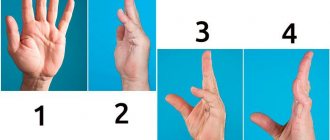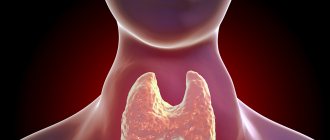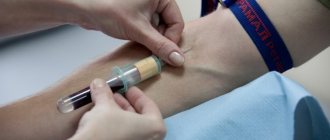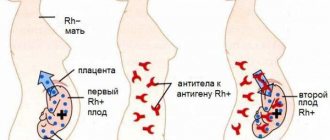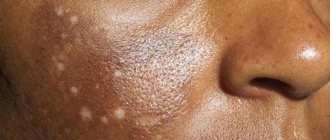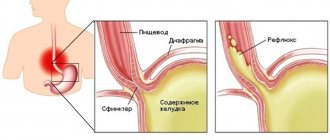This is a fairly rare disease that affects men between 30 and 60 years of age who are sexually active. At this age, the genital organ is more susceptible to microtrauma, including during sex. In men over 60, the disease is rare due to decreased sexual activity. The disease is named after the man who first described it in 1743. During Peyronie's disease, a man's penis becomes curved due to progressive fibrotic changes in its tunica albuginea.
Peyronie's disease (normal and curvature)
Photo: Patient with Peyronie's disease (Source: ru.wikipedia.org)
Nature and causes of Peyronie's disease
For a long time, experts believed that Peyronie's disease was endocrine in nature, and therefore they tried to treat the disease using hormones from the pituitary gland, adrenal glands and parathyroid glands. However, subsequently, experts increasingly began to be inclined to believe that the curvature of the penis is caused by injuries, for example, during forced sexual intercourse.
Among the reasons are the following:
- a wide range of injuries to the genital organ, for example, during sexual intercourse, from a blow or an accidental fall on a hard surface;
- microtraumas that are invisible to the eye and not accompanied by pain. They often occur during sexual intercourse;
- closed fracture of the penis, in which the integrity of the skin is not violated, but hemorrhage occurs;
- abnormalities of the immune system;
- diabetes;
- taking medications;
- the presence of narrowing of the lumen of blood vessels, which is characteristic of a disease such as atherosclerosis;
- a wide range of connective tissue diseases;
- gout – an increase in the level of uric acid in the blood;
- deficiency of vitamin E and calcium in the body;
- increased levels of serotonin in the body;
- the man's age. As the body ages, tissues lose their elasticity and are more susceptible to injury.
The role of a hereditary factor in the genesis of Peyronie's disease cannot be excluded. At a minimum, this is evidenced by Dupuytren's contracture, which occurs in more than half of patients with Peyronie's pathology.
Classification and types of disease
Peyronie's disease can lead to three types of penile curvature: dorsal, ventral, lateral. In the first case, the penis in men “looks” upward; with ventral deviation, it is directed downward, and with lateral deviation, the lateral deformation of the penis is called. Treatment is not required if the curvature is mild, is not associated with pain and does not interfere with sexual intercourse.
Depending on the stage of its progression, Peyronie's disease is divided into:
- pain – men complain of severe pain not only during an erection, but also at rest. Only in isolated cases does the manifestation of pain not bother men, and the reason for contacting a doctor is a well-palpable plaque. Often its size does not exceed two centimeters;
- functional - in addition to causing pain, such an illness leads to the inability to lead a normal sexual life.
Since Peyronie's disease has a very high tendency to progress, self-diagnosis and, especially, self-medication are unacceptable here. If pain occurs in the head and body of the penis, you should immediately consult a urologist. Only at this stage is consultation with this specialist effective and can prevent the disease.
Prices for services
Initial appointment with a urologist FOR MEN + ultrasound of the prostate gland (assessment of complaints, medical history, if necessary, rectal digital examination, ultrasound of the prostate gland in men)
Primary appointment – visiting a doctor of a specific specialty for the first time. Includes a conversation with the patient, an initial examination, anamnesis, if necessary, a digital rectal examination, and an ultrasound of the prostate gland. The price is valid from 02/01/2021 The price is not valid for appointments at the branches of Bolshevikov Ave. and Prosveshcheniya Ave. Make an appointment
550 ₽
Initial appointment with manager Department of Urology Rylchikov I.V. + Ultrasound (includes a conversation with the patient, initial examination, medical history, if necessary, rectal digital examination, ultrasound of the prostate gland)
Primary appointment – visiting a doctor of a specific specialty for the first time. Make an appointment
1200 ₽
Repeated appointment with the urologist
Make an appointment
700 ₽
How dangerous is the disease? Symptoms of Peyronie's disease
Peyronie's disease is dangerous not only because it leads to curvature of the penis. The progressive development of fibrous plaques causes pain during erection, which makes sexual intercourse impossible. Ultimately, Peyronie's disease leads to the development of erectile dysfunction.
The most common symptoms of Peyronie's disease are:
- Pain in the penis during erection (enlargement and tension of the penis during sexual arousal).
- Curvature of the penis to the side, to the side of the abdomen, towards the sac.
- The presence of a compacted area under the skin of the penis.
- Deterioration of erection. During sexual arousal, the penis does not enlarge and does not harden to the required volume.
- Functional shortening of the penis. A decrease in the size of the penis is not due to a decrease in length, but to its curvature.
Extracorporeal shock wave therapy (ESWT).
Widespread use of ESWL (external beam lithotripsy) in the treatment of urolithiasis in domestic and foreign literature, data on the successful use of ESWT in the treatment of Peyronie's disease have increasingly begun to appear. Treatment is carried out on a lithotripter with an intensity of 1000 pulses per session, with a maximum power of 12-13 kV. Sessions are performed once a week, with a total number of 2 to 12. Anesthesia is not required when performing ESWT. Methodology: the patient is placed in a prone position, the penis is placed on the therapeutic pad of the lithotripter and pressed with the patient’s body weight. The pressure in the therapeutic pillow increased to the maximum (equal to 8). This was done to approximate the geometric focus of the fibroplastic plaque. Side effects: the appearance of shallow abrasions and single petechiae, which did not require special treatment. Results: after the first sessions, pain during erection disappeared in most patients, and the curvature of the penis became less pronounced. The size of the plaques decreased in all patients, became less dense, and the clarity of the boundaries of fibrous plaques disappeared. Special research methods (ultrasound of penile blood flow) revealed a decrease in the number of vessels around plaques, which were previously considered highly vascularized. ESWT gives the best results when the disease lasts less than a year, when gross changes in the tissues have not yet developed, and in which conservative treatment methods have not yet been applied. Under these conditions, long-term remission is achieved. In cases of long-term existence of Peyronie's disease (more than 2 years), previous use of intracavernosal injections, or complications of these injections (hematoma), the use of ESWT is ineffective. Such patients should be recommended surgical treatment. ESWT does not produce immediate results.
Thus, a new method in the treatment of Peyronie's disease - extracorporeal shock wave therapy - can be recommended for the treatment of this disease, although it requires further study.
Make an appointment
Diagnosis of Peyronie's disease
As a rule, the characteristic clinical picture of the disease and the presence of an inflammatory process of the penis in the anamnesis do not leave any questions about the diagnosis. For more accurate information about the number, location and structure of plaques, instrumental research methods are used. The results of ultrasound and radiography can become irreplaceable information when choosing the volume and method of surgery.
What exactly and how does a urologist andrologist check? Let's take a closer look. First of all, information is collected regarding the time of onset of the first symptoms of the disease and previous illnesses of both the patient and his immediate family. This is done to identify the cause of the expression or confirmation of a hereditary factor. Next, the patient fills out specially designed tests aimed at determining the quality of sexual life; direct examination by a urologist of the genital organ in a state of erection. This process will be accelerated if the patient himself brings a photo of the penis in different projections. An ultrasound of the vessels of the penis is prescribed - it is carried out to assess blood circulation in the area of the lump. If necessary, an MRI of the genital organ is performed - the technique makes it possible to obtain a layer-by-layer image of the tissues of the organ. This is the most informative diagnostic method, allowing you to determine the location of the plaque and its volume. Cavernosography is the introduction of a special contrast agent into the internal structures of the penis and radiography.
Complications
Although this disease is not life-threatening, if left untreated it can lead to sexual dissatisfaction, painful erections and irreversible functional impairment.
The course of the disease is also complicated by the danger of psychotraumatization of patients who are seriously experiencing their “illness.”
With a small percentage of penis deviation, this cannot yet be called a disease. Peyronie's disease is accompanied by a significant increase in fibrous tissue, leading to the formation of compactions - this can ultimately lead to the inability to perform sexual intercourse (dysfunction).
Prevention of Perioni's disease
Since the exact causes of the disease are still unknown, it is difficult to offer specific prevention of Peyronie’s disease. However, men are advised to adhere to a certain lifestyle to minimize the occurrence of the disease.
- Healthy lifestyle (healthy diet, exercise, regular checkups).
- Wear comfortable underwear and loose pants.
Article information
| Last update | April 21, 2021 |
| Next update | April 21, 2022 |
| Author | Potapov S.A. |
| Medical editor | Doctor Plekhanov A.Yu. |
Bibliography
- Guidelines on Penile Curvature; European Association of Urology (2015)
- Bilgutay AN, Pastuszak AW; Peyronie's Disease: a Review of Etiology, Diagnosis and Management. Curr Sex Health Rep. 2015 Jun 17(2):117-131. doi: 10.1007/s11930-015-0045-y.
- Gelbard MK, et al. The natural history of Peyronie's disease. J Urol 1990 144(6): p. 1376-9.
- Jarow JP, et al. Penile trauma: an etiologic factor in Peyronie's disease and erectile dysfunction. J Urol 1997 158(4): p. 1388-90.
Conservative treatment
It consists of the internal use of oral medications, local injection into the affected areas, physiotherapy and remote shock wave therapy. The commonly used oral medications are colchicine, procarbazine, vitamin E, pentoxifylline, and potassium aminobenzoate. Previously, glucocorticoids were used to treat the disease, but they were found to be ineffective and are no longer prescribed.
To administer medications directly into the plaque, the following are used:
- steroid hormones;
- Collagenase (prescribed for penile curvatures of no more than 30°);
- Verapamil is a calcium channel antagonist (effectively reduces plaque area and stiffness).
However, the use of local injections, although much more effective than systemic treatment with medications, carries a hidden threat. After injections, additional injuries to the tunica albuginea may occur, leading to new inflammatory processes, increased plaque or neoplasms.
Physiotherapeutic treatment includes procedures such as:
- magnetic therapy;
- diadynamic currents;
- laser therapy;
- mud therapy;
- electrophoresis;
- shock wave therapy.
With shock wave therapy, a special device generates a series of pulses, which the specialist directs through a nozzle directly to the plaque. As a result, the seals on the tunica albuginea soften and the penis straightens. This technique is used for penile curvatures of no more than 45°.
Causes of pathology
The etiology of male Peyronie's disease has not been thoroughly studied. According to most doctors, the cause of fibrotic changes is microtrauma of the membranes of the cavernous bodies. Men can get them as a result of an inflammatory process, active coitus or injury, or surgery.
At the site of injury, an inflammatory process occurs, the formation of hematomas and damage to protein structures leads to a protective reaction of the body - compaction, and the transformation of connective tissue into fibrous tissue occurs.
Operation
For Peyronie's disease, surgical treatment is more effective, since it allows one to simultaneously correct the curvature and remove compacted nodes. The surgical procedure is determined in each case of Paironi's disease individually.
So, if the curvature of the penis is less than 45 degrees, and its length is sufficient, then plication, when the defect is corrected by applying folds on the opposite side, is most preferable. The tissue is sutured with non-absorbable suture material, the penis loses some length, but the likelihood of complications is minimal.
If the length of the penis is sufficient and the curvature is more than 45 degrees, the tunica albuginea is excised in the form of ellipses, and the side opposite the curvature is sutured with non-absorbable suture material. If the length of the penis is insufficient or if the patient refuses the above methods, they resort to dissection or excision of the plaque, followed by the use of plastic surgery. A defect in the tunica albuginea is eliminated using the tunica vaginalis of the testicle, a skin flap, or synthetic materials.
If Peyronie's Disease occurs with erectile dysfunction, then the optimal solution is penile prosthesis or dildo implantation. This allows you to eliminate problems with erection and correct the curvature of the penis.
Treatment with folk remedies
For Peyronie's disease, it is better to adhere to traditional methods of treatment, since traditional medicine may not only not help the patient, but also worsen his condition.
As a rule, traditional healers use local compresses and lotions, which only intensify the processes of inflammation and exudation in the body of the penis. This is accompanied by the progression of Peyronie's disease. Thus, the use of folk remedies during such a disease is unacceptable.
